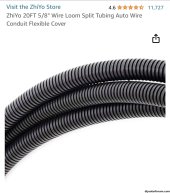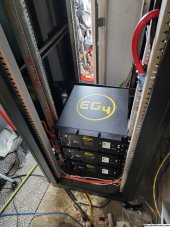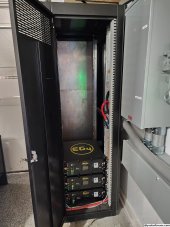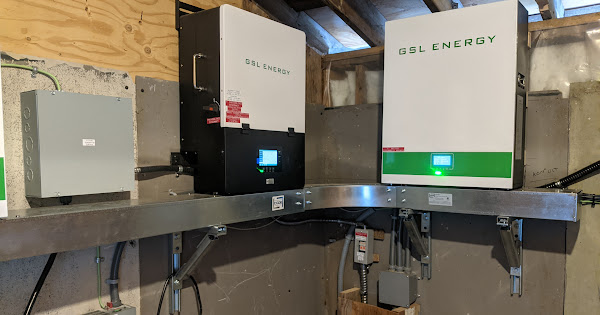Yes....but No. I have my property completely gated off so nobody can get in and be nosey (legally). The improvements may require permits, but what one doesn't know doesn't hurt them. I don't live in a "residential" area at all. My nearest neighbor is about a mile away.Now that your inspection is approved, will further iterations need approval?
You are using an out of date browser. It may not display this or other websites correctly.
You should upgrade or use an alternative browser.
You should upgrade or use an alternative browser.
Failed Inspection - need some advice and guidance for NEC 690 infractions.
- Thread starter meager
- Start date
TomC4306
Solar Obsessive
Put the controller in an enclosure connected to the raceways?This post just made me realize I'm not sure how a Victron charge controller can pass since there is no way that I can think of to have the 30VDC+ PV wire enclosed in a metal raceway. The controller expects only the cables themselves to entire the bottom of the controller.
Or run you PV wire into a common metal junction box if indoors, then split them out in pairs via rigid metal conduit or flexible metal conduit. It looks like the victron will accept probably 3/4" for each PV string?Put the controller in an enclosure connected to the raceways?
Zapper77
Renaissance Man
- Joined
- Jul 23, 2022
- Messages
- 2,344
Did the NEC say something like Metal to the first means of disconnect for PV?Or run you PV wire into a common metal junction box if indoors, then split them out in pairs via rigid metal conduit or flexible metal conduit. It looks like the victron will accept probably 3/4" for each PV string?
zanydroid
Solar Wizard
I think the first disconnect is an old rule:
690.31(D) Direct-Current Circuits on or in Buildings.
Where inside buildings, PV system dc circuits that exceed 30 volts or 8 amperes shall be contained in metal raceways, in Type MC metal-clad cable that complies with 250.118(10), or in metal enclosures.
www.electricallicenserenewal.com
NEC 2017 requires metal to the first disconnect, NEC 2020 and later require all of PV system dc circuits in metal raceways and enclosures.Did the NEC say something like Metal to the first means of disconnect for PV?
From the moment PV DC (above 30V) crosses the threshold to the interior, it needs to be in metal. I started my transition just outside of the power shed with a metal LB connector and it just continues throughout the interior of the shed. I know it says metal to the first disconnect, but just to be safe, you might as well take it all the way to your inverters if possible. Better safe than sorry IMO.Did the NEC say something like Metal to the first means of disconnect for PV?
Zapper77
Renaissance Man
- Joined
- Jul 23, 2022
- Messages
- 2,344
Residence or a non-residential Accesory Building?From the moment PV DC (above 30V) crosses the threshold to the interior, it needs to be in metal. I started my transition just outside of the power shed with a metal LB connector and it just continues throughout the interior of the shed. I know it says metal to the first disconnect, but just to be safe, you might as well take it all the way to your inverters if possible. Better safe than sorry IMO.
zanydroid
Solar Wizard
The 690.31 excerpt from my post says building.
For my installation, it is an "out-building" located 10 feet from my home for use as a solar power shed. I would agree with @zanydroid that the code says "building". I wouldn't go too far in the weeds and try and draw your own conclusion as to what that means. If the "building" can catch fire, it very likely needs to be enclosed in metal and protected as such. My limited experience tells me that there really isn't any room for your definition of this or that. With the use of an inexpensive tube / pipe cutter, it really is quite an easy installation. The key is to do it right the FIRST timeResidence or a non-residential Accesory Building?
Zapper77
Renaissance Man
- Joined
- Jul 23, 2022
- Messages
- 2,344
My location applys different rules to non-residential (detatched) accessory buildings. Just asked for clarification.For my installation, it is an "out-building" located 10 feet from my home for use as a solar power shed. I would agree with @zanydroid that the code says "building". I wouldn't go too far in the weeds and try and draw your own conclusion as to what that means. If the "building" can catch fire, it very likely needs to be enclosed in metal and protected as such. My limited experience tells me that there really isn't any room for your definition of this or that. With the use of an inexpensive tube / pipe cutter, it really is quite an easy installation. The key is to do it right the FIRST time
timselectric
If I can do it, you can do it.
- Joined
- Feb 5, 2022
- Messages
- 19,828
While non inhabitant buildings have more lax requirements. I tend to do everything the same, everywhere. Especially when safety is involved.
Pilot Bob
New Member
Put your PV wires in EMT inside the building.
I assume they are talking about Raceways, boxes you have things in must have a ground lug with ground wire back to main grounding source.
No idea unless it means covered.
I’m sure some of the electricians on here can tell you more.

 Use something like this to cover and protect the wiring.
Use something like this to cover and protect the wiring.Quattrohead
Solar Wizard
DC must be in a metal conduit.
timselectric
If I can do it, you can do it.
- Joined
- Feb 5, 2022
- Messages
- 19,828
NopeView attachment 176724View attachment 176724Use something like this to cover and protect the wiring.
Ampster
Renewable Energy Hobbyist
That is okay for autos but not code for this purpose. As mentioned upthread, DC must be in metal conduit.Use something like this to cover and protect the wiring.
robbob2112
Doing more research, mosty harmless
I'd love to see pictures inside those showing the connections and grounds and runs and connections. That looks slick and exceptionally neat. When I do mine I want it to look that neat. Can you link to the server cabinet you chose?Unfortunately I didn't read through all 9 pages to see where this has all gone, but to give you some added empathy I also had to go through some of the steps you're having to do because of inspection, all the while being jealous of the other installs where some of the things I feel give no added safety in the first place could be skipped.
View attachment 161930
My local inspector also made me do some things that I'm 80% weren't needed in the latest version of code but weren't worth me fighting, such as using rigid conduit on my underground sections and not allowing me to run my 48V cables inside the raceway with my AC runs, but still requiring it to be in metallic. That liquid tight is metallic. But yes 100% of my high voltages lines are in metal 100% of the time after leaving the array.
was just watching this video... about that very UL9540A and UL9540 and Energy (Battery) Storage Systems https://www.ul.com/resources/energy-storage-systems-what-you-need-know-about-ul-9540-and-9540aIt needs to be an approved UL9540 pair of inverter and battery combination. The battery positioning and protection within the structure is also prescribed in NEC or international residential code as adopted by your state (I think the latter). So that might be another rude awakening if inspector finds deviation from those rules.
Unfortunately it is possible that your AHJ only did a cursory plan check.
UL9540A is not the same as UL9540 and gives you no points for that.
UL1973 is a strict subset of UL9540 and code says you need UL9540
zanydroid
Solar Wizard
Nice. That one is 3 years old though so there might be some minor updates.was just watching this video... about that very UL9540A and UL9540 and Energy (Battery) Storage Systems https://www.ul.com/resources/energy-storage-systems-what-you-need-know-about-ul-9540-and-9540a
Unfortunately I was still finishing all this up after my wife's due date so I did a terrible job of taking pictures. Here's a couple. Idk why but I have almost none of the copper bus bars which live under the grey covers. It's just some bar I got off mcmaster that I drilled and tapped to take the 6awg that comes with the EG4 batteries.I'd love to see pictures inside those showing the connections and grounds and runs and connections. That looks slick and exceptionally neat. When I do mine I want it to look that neat. Can you link to the server cabinet you chose?
The 4/0 positive attaches at the bottom of the left bus bar, negative attaches at the top of the right. Fuse box before the wire leaves the cabinet. If I ever add enough batteries so the sum of the breakers on them exceed the capacity of the wire I'll move it closer to the bus bar. I have a 6awg grounding the entire cabinet.
Brackets to hold the batteries is just some angle steel.
The cabinet itself was an old one I got for free from my job. In hindsight, I spent so much time and effort and money converting this one I kinda wish I just got the pre-made EG4 one, you can usually get it for free more or less.


So, I'm wondering, what is it specifically that keeps something from being run from the raceway to the bottom cabinet of the inverter (e.g. FMC) ? What if the inverter has fans along bottom right where the 48vdc comes through?In regards to 3), I had to do that. Canadian code, but similar.

New item by Derek Jacoby
photos.app.goo.gl
Just so you know, now he's got you setup for perfect Electromagnetic pulse burst during a High current event like lightning strike anywhere nearby. Sure to send that pulse right through all the panels and equipment. :/My inspector has required me to put in 3 total ground rods. 1 at the array and 2 at the power shed at least 6 ft apart. I'm pretty good at pounding in ground rods at this point. Instead of purchasing or renting at large hammer drill, I've just been using a t-post hammer and it works perfectly fine in my cases. I already had the t-post hammer for all of the the fencing I have to install anyways.
Electricity unlike all the lies we've been told about it, does NOT follow the path to least resistance. That was one of the lessons Mike Holt had to beat out of my programmed head.@cs1234 Overkill, yes, but not at all dangerous. It's all about creating the path of least resistance.
Similar threads
- Replies
- 1
- Views
- 420
- Replies
- 5
- Views
- 350
- Replies
- 75
- Views
- 6K
- Replies
- 8
- Views
- 425
- Replies
- 25
- Views
- 815



